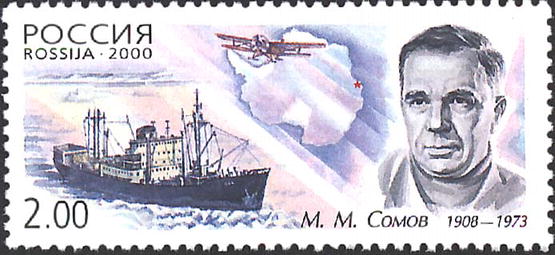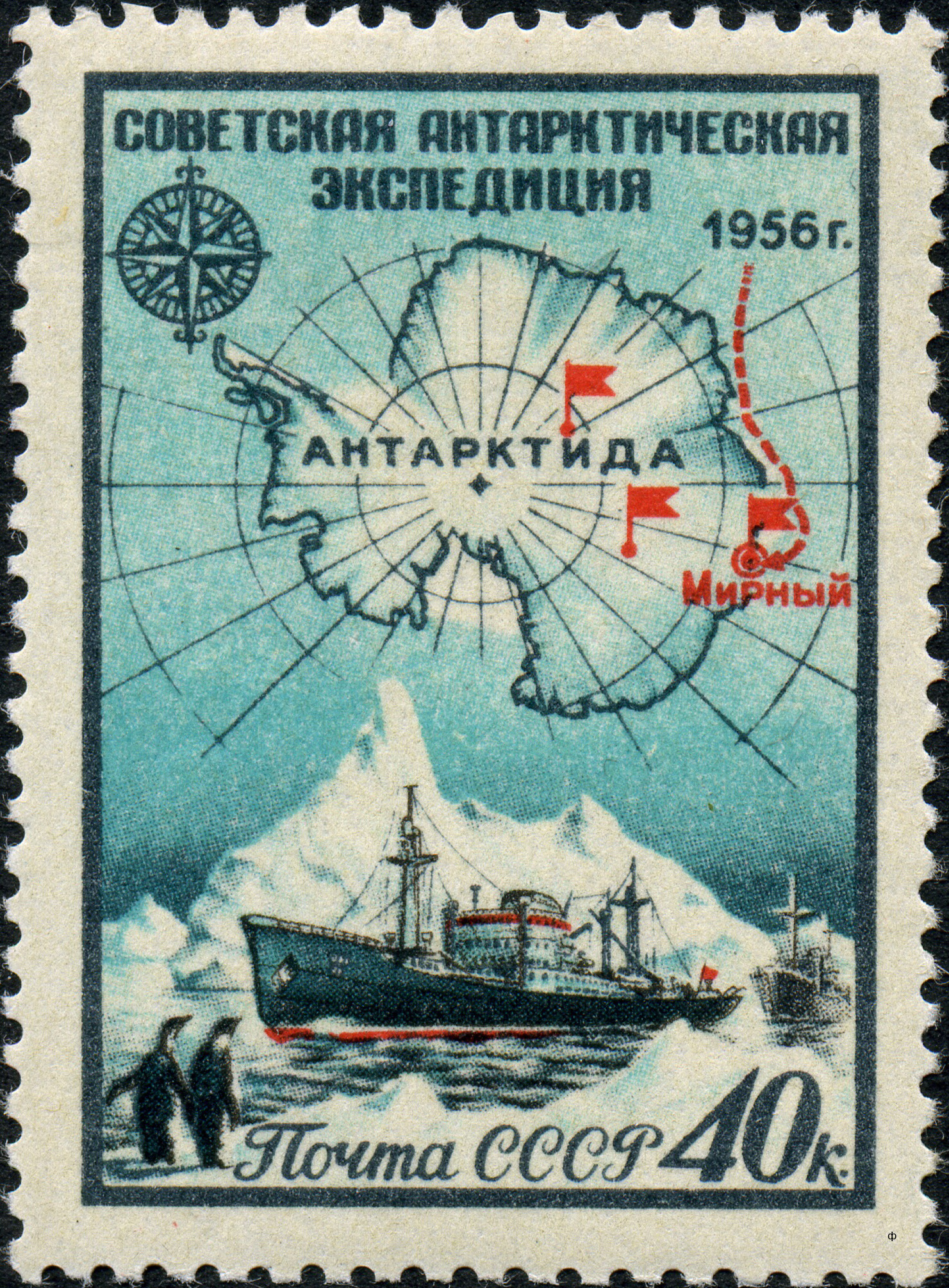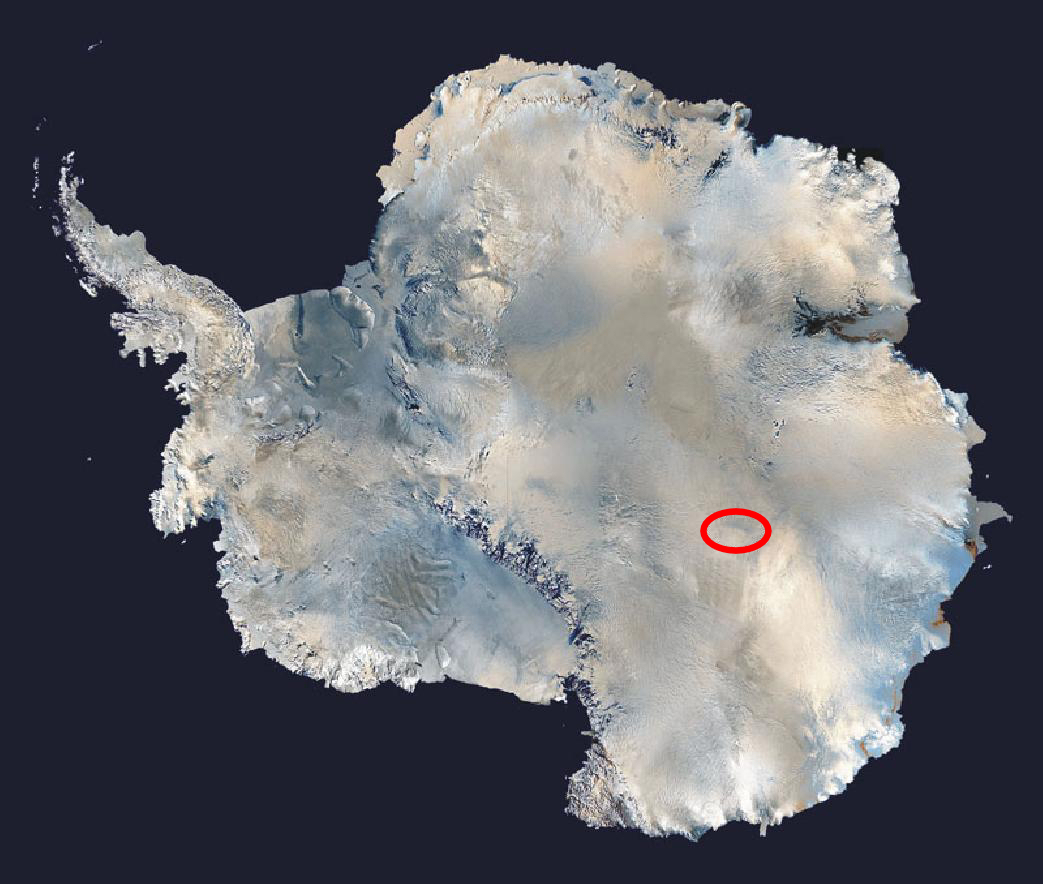|
1st Soviet Antarctic Expedition
The First Soviet Antarctic Expedition was led by Mikhail Somov; his scientific deputy was . The expedition lasted from 30 November 1955 to 1957 and involved 127 expedition members and 75 crew members. Three diesel-electric ships were used to transport the expedition. They were ''RV Ob'' (flagship; captain ), ''RV Lena'' (captain A. I. Vetrov) and the refrigerator ship No. 7 (captain M. A. Tsygankov). The final ship was used only for transporting perishables. ''Ob'' and ''Lena'' were icebreakers 130m long and displacing 12,600 tons. On 30 November 1955 ''Ob'' left port at Kaliningrad. The principal task of the expedition was to organise the main base, Mirny, and perform limited scientific observations. Other tasks were reconnaissance of sites for the inland bases Vostok and Sovetskaya; and oceanography of the Indian ocean. References * A V Nudel Man ''Soviet Antarctic Expeditions 1955-1959'', Izdatel'stvo Akademii Nauk SSSR, Moskva, 1959 (translated from the Russian; Israel pr ... [...More Info...] [...Related Items...] OR: [Wikipedia] [Google] [Baidu] |
Mikhail Somov
Mikhail Mikhailovich Somov (russian: Михаил Михайлович Сомов; , in Moscow – 30 December 1973, in Leningrad) was a Soviet oceanologist, polar explorer, Doctor of Geographical Sciences (1954). Somov graduated from the Moscow Hydrometeorological Institute in 1937. In 1939, he was appointed senior researcher at the Arctic and Antarctic Research Institute. In 1950–1951, Mikhail Somov headed a drift-ice station ''North Pole-2''. In 1955–1957, he became the commander of the first Soviet Antarctic Expedition. Mikhail Somov was also the first Soviet delegate to the Scientific Committee on Antarctic Research. The Somov Sea north of Victoria Land and a glacier in Queen Maud Land (both East Antarctica) bear Mikhail Somov's name, as well as a scientific icebreaker. A minor planet 3334 Somov discovered by Czech astronomer Antonín Mrkos in 1981 is named after him. Somov was awarded the title Hero of the Soviet Union in 1952. Awards * Hero of the Soviet Union (195 ... [...More Info...] [...Related Items...] OR: [Wikipedia] [Google] [Baidu] |
Kaliningrad
Kaliningrad ( ; rus, Калининград, p=kəlʲɪnʲɪnˈɡrat, links=y), until 1946 known as Königsberg (; rus, Кёнигсберг, Kyonigsberg, ˈkʲɵnʲɪɡzbɛrk; rus, Короле́вец, Korolevets), is the largest city and administrative centre of Kaliningrad Oblast, a Russian semi-exclave between Lithuania and Poland. The city sits about west from mainland Russia. The city is situated on the Pregolya River, at the head of the Vistula Lagoon on the Baltic Sea, and is the only ice-free port of Russia and the Baltic states on the Baltic Sea. Its population in 2020 was 489,359, with up to 800,000 residents in the urban agglomeration. Kaliningrad is the second-largest city in the Northwestern Federal District, after Saint Petersburg, the third-largest city in the Baltic region, and the seventh-largest city on the Baltic Sea. The settlement of modern-day Kaliningrad was founded in 1255 on the site of the ancient Old Prussian settlement ''Twangste'' by th ... [...More Info...] [...Related Items...] OR: [Wikipedia] [Google] [Baidu] |
Mirny Station
The Mirny Station (russian: Мирный, literally ''Peaceful'') is a Russian (formerly Soviet) first Antarctic science station located in Queen Mary Land, Antarctica, on the Antarctic coast of the Davis Sea. The station is managed by the Arctic and Antarctic Research Institute and was named after the support vessel '' Mirny'' captained by Mikhail Lazarev during the First Russian Antarctic Expedition, led by Fabian Gottlieb von Bellingshausen on ''Vostok''. Mirny Station was damaged by a fire on Sunday 21 June 2020. Purpose and facilities The station was opened on February 13, 1956, by the 1st Soviet Antarctic Expedition. It was originally used as main base for the Vostok Station located from the coast, this function is now served by Progress Station. In summer, it hosts up to 169-200 people in 30 buildings, in winter about 40-50 scientists and technicians. The average temperature at the location is , and on more than 200 days per year the wind is stronger than , with occa ... [...More Info...] [...Related Items...] OR: [Wikipedia] [Google] [Baidu] |
Vostok Station
Vostok Station (russian: :ru:Восток (антарктическая станция), ста́нция Восто́к, translit=stántsiya Vostók, , meaning "Station East") is a Russian Research stations in Antarctica, research station in inland Princess Elizabeth Land, Antarctica. Founded by the Soviet Union in 1957, the station lies at the southern Pole of Cold, with the List of weather records#Lowest temperatures recorded, lowest reliably measured natural temperature on Earth of .Global Measured Extremes of Temperature and Precipitation. National Climatic Data Center. Retrieved on 21 June 2007. Research includes ice core drilling and Magnetometer, magnetometry. Vostok (Russian for ''"east"'') was named after ''Vostok (sloop-of-war), Vostok'', the lead ship of the First Rus ... [...More Info...] [...Related Items...] OR: [Wikipedia] [Google] [Baidu] |
Sovetskaya (Antarctic Research Station)
Sovetskaya was a Soviet research station in Kaiser Wilhelm II Land in Antarctica that was established on 16 February 1958 and closed on 3 January 1959. The surface elevation was initially reported to be ; however, it was later revised to . Reached on 16 February 1958 by the 3rd Soviet Antarctic Expedition for International Geophysical Year research work, it closed on 3 January 1959. Its WMO reporting ID was 89557. See also *Sovetskaya (lake) * List of Antarctic research stations * List of Antarctic field camps Many Antarctic research stations support satellite field camps which are, in general, seasonal camps. The type of field camp can vary – some are permanent structures used during the annual Antarctic summer, whereas others are little more than te ... Sources Outposts of Antarctica Polar exploration by Russia and the Soviet Union Outposts of Kaiser Wilhelm II Land Soviet Union and the Antarctic 1959 disestablishments in the Soviet Union 1959 disestablish ... [...More Info...] [...Related Items...] OR: [Wikipedia] [Google] [Baidu] |
Indian Ocean
The Indian Ocean is the third-largest of the world's five oceanic divisions, covering or ~19.8% of the water on Earth's surface. It is bounded by Asia to the north, Africa to the west and Australia to the east. To the south it is bounded by the Southern Ocean or Antarctica, depending on the definition in use. Along its core, the Indian Ocean has some large marginal or regional seas such as the Arabian Sea, Laccadive Sea, Bay of Bengal, and Andaman Sea. Etymology The Indian Ocean has been known by its present name since at least 1515 when the Latin form ''Oceanus Orientalis Indicus'' ("Indian Eastern Ocean") is attested, named after Indian subcontinent, India, which projects into it. It was earlier known as the ''Eastern Ocean'', a term that was still in use during the mid-18th century (see map), as opposed to the ''Western Ocean'' (Atlantic Ocean, Atlantic) before the Pacific Ocean, Pacific was surmised. Conversely, Ming treasure voyages, Chinese explorers in the Indian Oce ... [...More Info...] [...Related Items...] OR: [Wikipedia] [Google] [Baidu] |
Polar Record
''Polar Record'' is a quarterly peer-reviewed academic journal covering all aspects of Arctic and Antarctic exploration and research. It is managed by the Scott Polar Research Institute and published by Cambridge University Press. The journal was established in 1931 and the Co-editors-in-chief are Dr Nikolas Sellheim (University of Helsinki) and Dr Trevor McIntyre (University of South Africa). Abstracting and indexing The journal is abstracted and indexed in: The journal had a 2019 impact factor of 0.84. History The journal was established in 1931, by The Scott Polar Research Institute which itself was founded in 1926. The foreword of the first issue in the first volume stated that the journal was created to address the challenge of "so much exploration and exploitation in the polar regions, the news of which appear in so many forms and languages", and that "in the first place an attempt will be made merely to record the chief polar events of the preceding six months; but it i ... [...More Info...] [...Related Items...] OR: [Wikipedia] [Google] [Baidu] |
List Of Soviet Antarctic Expeditions
List of Antarctic expeditions by the Soviet Union is a list of expeditions from the Soviet Union to Antarctica. Expeditions ordered by date See also * Soviet Antarctic Expedition * List of Antarctic expeditions * List of Russian explorers The history of exploration by citizens or subjects of the Russia, Russian Federation, the Soviet Union, the Russian Empire, the Tsardom of Russia and other Russian predecessor states forms a significant part of the history of Russia as well as th ... {{Polar exploration List Expeditions by the Soviet Union Soviet Antarctic ... [...More Info...] [...Related Items...] OR: [Wikipedia] [Google] [Baidu] |
2nd Soviet Antarctic Expedition
The Second Soviet Antarctic Expedition was led by Aleksei Treshnikov on the continent; the marine expedition on the "Ob" was led by I. V. Maksimov. The "Ob" left Kaliningrad on 7 November, 1956. Three ships were used to transport the expedition, all diesel-electric. The two main ships were as for the first expedition: RV ''Ob'' (flagship; captain )) and RV "Lena" (captain A. I. Vetrov). The third ship was ''Kooperatsiya'' (captain A. S. Yantselevich), used mainly as a transport vessel. The tasks of the expedition were: # Relief of the first expedition # Full scale scientific work for the International Geophysical Year (IGY) This included glacier mapping and wildlife tracking, among other things. # Organisation of two IGY scientific stations near the south geomagnetic pole and pole of relative inaccessibility # An inland tractor-sledge traverse for glaciology # Oceanography List of features named by the expedition * Lena Passage, named after the ship ''Lena'' * Lednikov Bay (B ... [...More Info...] [...Related Items...] OR: [Wikipedia] [Google] [Baidu] |
Soviet Antarctic Expeditions
The Soviet Union,. officially the Union of Soviet Socialist Republics. (USSR),. was a List of former transcontinental countries#Since 1700, transcontinental country that spanned much of Eurasia from 1922 to 1991. A flagship communist state, it was nominally a Federation, federal union of Republics of the Soviet Union, fifteen national republics; in practice, both Government of the Soviet Union, its government and Economy of the Soviet Union, its economy were highly Soviet-type economic planning, centralized until its final years. It was a one-party state governed by the Communist Party of the Soviet Union, with the city of Moscow serving as its capital as well as that of its largest and most populous republic: the Russian Soviet Federative Socialist Republic, Russian SFSR. Other major cities included Saint Petersburg, Leningrad (Russian SFSR), Kyiv, Kiev (Ukrainian Soviet Socialist Republic, Ukrainian SSR), Minsk (Byelorussian Soviet Socialist Republic, Byelorussian SSR), Tas ... [...More Info...] [...Related Items...] OR: [Wikipedia] [Google] [Baidu] |
1955 In The Soviet Union
The following lists events that happened during 1955 in the Union of Soviet Socialist Republics. Incumbents * First Secretary of the Communist Party of the Soviet Union – Nikita Khrushchev * Chairman of the Presidium of the Supreme Soviet of the Soviet Union – Kliment Voroshilov * Chairman of the Council of Ministers of the Soviet Union – Georgy Malenkov (until 8 February), Nikolai Bulganin (starting 8 February) Events February * 27 February ** 1955 Estonian Supreme Soviet election ** 1955 Soviet Union regional elections May * 14 May – Warsaw Pact June * 2 June – Belgrade declaration November * 15 November – Władysław Gomułka initiates talks about the Repatriation of Poles (1955–59). * 22 November – The first Soviet hydrogen bomb, RDS-37, is tested. * 30 November – The 1st Soviet Antarctic Expedition begins. December * 31 December – The Pospelov Commission is set up. Births * 1 January – Gennady Lyachin, Russian submarine captain (d. 2000) * 29 Jan ... [...More Info...] [...Related Items...] OR: [Wikipedia] [Google] [Baidu] |




